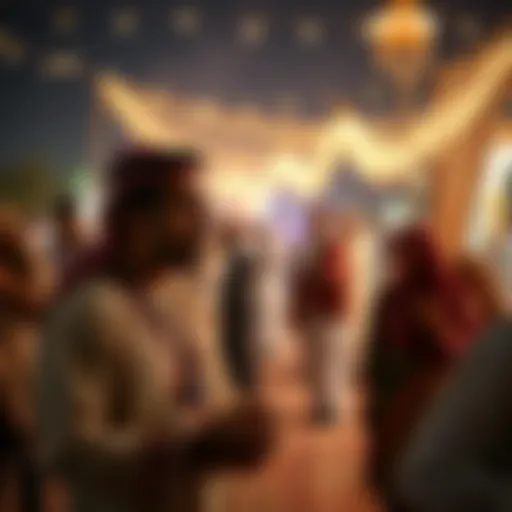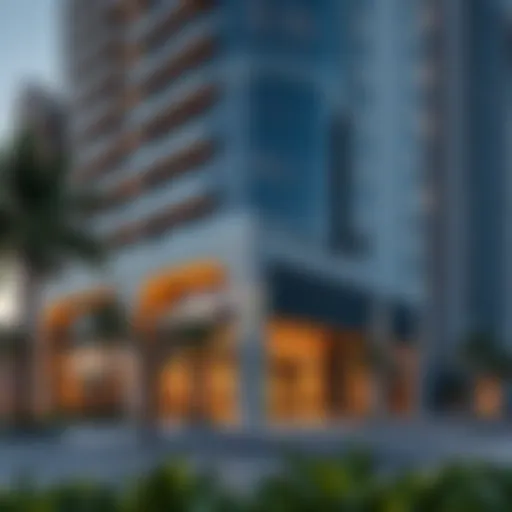Latifa Tower and World Trade Center: Architectural Insights


Intro
In the heart of Dubai's skyline, two structures stand tall and proud: the Latifa Tower and the World Trade Center. These architectural giants are not merely feats of engineering; they represent the pulsating heartbeat of the city’s real estate market and its rapid economic transformation. Their unique designs and monumental presence contribute significantly to the urban fabric of Dubai, while also serving as magnets for investors, businesses, and tourists alike.
Both towers have distinct identities, yet share a common thread—embodying the innovative spirit of Dubai. Understanding these buildings requires more than just an appreciation for aesthetics. It necessitates a dive into their historical contexts, architectural delights, and economic implications that shape not just their existence but the overall landscape of Dubai.
As we embark on this exploration, the following sections will provide insights into the real estate market trends specific to these structures, investment strategies for prospective buyers, and the broader implications of these developments on the urban community and standard of living in Dubai.
Prelude to Latifa Tower and World Trade Center
The exploration of Latifa Tower and the World Trade Center is not just about towering structures in Dubai; it's a deep dive into the essence of modern architectural feats and their implications for urban development. These buildings stand as symbols of innovation, drawing in investors, expats, and tourists alike, while significantly impacting the city's real estate market and skyline.
By understanding the nuances of Latifa Tower and the World Trade Center, we gain insights into their architectural significance, economic contributions, and cultural relevance. In an era where space is a premium and the skyline is ever-changing, these structures serve to illustrate how Dubai deftly balances modernity with cultural identity.
Overview of Latifa Tower
Latifa Tower, known for its striking design and strategic location, plays a pivotal role in the architectural landscape of Dubai. Completed in 2007, this 65-story skyscraper stands firm against the backdrop of the city, symbolizing resilience and modernity. The developers wanted a structure that not only showcased innovative engineering but also harmonized with its environment. Built as a mixed-use property, Latifa Tower hosts residential apartments alongside commercial spaces, mixing dynamics to promote a lively community.
The design features a sleek glass façade and an eye-catching spiraled structure that breaks conventional architectural boundaries. This approach not only adds aesthetic value but also allows for better natural light penetration and views across the city. Moreover, Latifa Tower has embraced sustainability through initiatives that reduce resource consumption, aligning with Dubai's vision for a greener urban future.
Overview of World Trade Center
The World Trade Center in Dubai, inaugurated in 1977, stands as a landmark of international business and trade. Unlike many newly built skyscrapers, this structure embodies a rich history; initially, it comprised two towers now connected by a skybridge. The architectural design reflects a fusion of modernity and cultural symbolism, making it a focal point for both local and global enterprises.
The significance of the World Trade Center extends beyond its height and design. It has become a hub for business activity, drawing multinational corporations and fostering a vibrant commercial landscape. The center is home to several exhibition halls, hotels, and office spaces, which are crucial for attracting investments and hosting international events.
Both structures encapsulate more than mere physical presence; they are integral to Dubai's narrative of progress and economic growth, reflecting the ever-evolving dynamics of the city's real estate market. Understanding these attributes can provide valuable perspectives for investors and businesses looking to tap into Dubai’s vibrant economy.
"Dubai's architectural marvels are not just buildings; they are testaments to ambition and vision that define the city."
In the ensuing sections, we will dive deeper into their architectural designs, cultural significance, economic impacts, and the sustainability efforts both structures showcase. Each aspect plays a critical role in shaping the perception and future of these iconic structures.
Architectural Designs
Architectural design is a vital aspect of any urban landscape, serving as the canvas upon which culture, economics, and community dynamics unfold. In the case of Latifa Tower and the World Trade Center, these structures are not just mere buildings, but rather symbols of innovation and progress that speak to the aspirations of Dubai. The uniqueness of their designs reflects the zeitgeist of an era marked by a blend of traditional motifs and modern aesthetics, encapsulating the essence of a city that stands at the forefront of global architecture.
Moreover, architectural design impacts real estate values, shaping perceptions and driving demand. Investors and stakeholders find that designs that resonate with contemporary sensibilities often yield higher returns and enhance the longevity of these properties in a competitive market. Given that both Latifa Tower and the World Trade Center are pivotal points in Dubai’s commercial landscape, understanding their designs offers significant insight into their economic implications and community reach.
Style and Structure of Latifa Tower
Latifa Tower, piercing the Dubai skyline, is an impressive structural feat that radiates a sense of solidity and elegance. Designed by renowned architect WZMH Architects, it stands tall with a height of 400 meters. The structure is notable for its curvilinear form, which not only enhances its aesthetic appeal but also optimizes energy efficiency. The facade is adorned with a sophisticated glass cladding, enabling natural light to pour into the interior spaces and offering breathtaking views of the city and the Arabian Gulf.
The interior layout prioritizes spaciousness, reflecting a modern approach to functionality. The design promotes an open-concept space that fosters collaboration and creativity—essential for offices and commercial endeavors. What makes Latifa Tower particularly appealing is its blend of local architectural elements with global styles, making it a true landmark that symbolizes Dubai's ambition.
Design Elements of World Trade Center
In contrast, the World Trade Center exhibits a bold and innovative architectural language. Designed by the architectural firm Kohn Pedersen Fox Associates, its design encapsulates modernity while being intricately linked to the city's cultural fabric. The building incorporates a glass and steel facade that not only enhances its contemporary look but also reflects the surrounding skyline. One of its most striking features is its dynamic cantilever, which adds a distinct character to the structure while serving functional purposes such as shading and reducing heat gain.
At the ground level, the design fosters connectivity, featuring wide pedestrian walkways and green spaces that create a welcoming atmosphere. These elements have been strategically placed to engage with the community, reinforcing a sense of belonging and coexistence. The interior showcases versatile office spaces, designed with flexibility in mind to accommodate various business needs in a rapidly changing economic landscape.
In sum, the design elements of the World Trade Center represent more than just architectural innovation; they signify a commitment to creating spaces that cater to the needs of the modern urban dweller and investor.
"Architectural design is not just about building; it is about creating experiences and environments that foster economic growth and community interaction."
In looking at both Latifa Tower and the World Trade Center, one cannot help but appreciate how their architectural designs serve as a reflection of Dubai's ambition and its position on the global stage.
Cultural Significance
Cultural significance plays a pivotal role in shaping the identities of landmarks like the Latifa Tower and the World Trade Center. These structures are not merely bricks and mortar; they embody the aspirations, history, and social values of a community. Understanding their cultural implications helps investors, analysts, and urban planners appreciate the broader context within which these buildings exist. It also sheds light on how these developments influence the local populace while showing the world what Dubai stands for in terms of innovation and growth.
Cultural Context of Latifa Tower
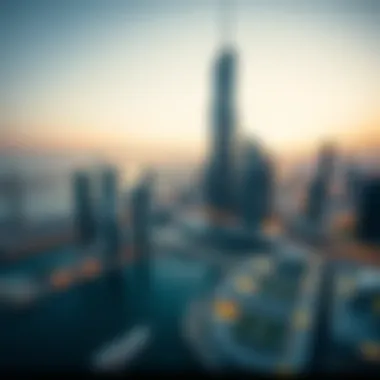

The Latifa Tower stands tall as a beacon of modern architectural finesse in Dubai. Designed to cater to both commercial and residential needs, it mirrors the shift in the city’s economic landscape towards a service-oriented economy. This tower is not just an office space; it serves as a cultural conduit, facilitating interactions among various社会 segments.
The design incorporates traditional elements that resonate with Dubai's rich heritage, making it not only a functional structure but also a symbol of cultural preservation. Local artists often exhibit their work within its confines, creating a dialogue between past and present. The establishment of cultural events and initiatives frequently around the tower gears to cement its place as a community landmark. This also provides substantial encouragement for investors keen on nurturing societal growth through cultural integration.
Economic and Social Impact
- Job Creation: The tower has been a catalyst for job opportunities, ranging from corporate roles to retail positions, contributing to the local economy.
- Networking Hub: Latifa Tower acts as a meeting point for entrepreneurs and established business figures, fostering relationships that could lead to innovative projects.
- Cultural Programs: Regular exhibitions and cultural showcases help preserve Emirati traditions, thereby enriching the local identity and attracting tourism.
By aligning economic objectives with community needs, the Latifa Tower showcases a thoughtful approach to urban development, making it a cornerstone of Dubai’s vibrant culture.
World Trade Center as a Cultural Landmark
When one thinks of the World Trade Center in Dubai, the mind often conjures images of global business transactions and towering height, but its cultural significance is equally noteworthy. This center stands as a vital hub that connects local customs with global economic frameworks. Alongside its impressive skyscrapers, the World Trade Center embodies Dubai’s ambition to become a global player in trade and commerce.
The architectural style, often described as futuristic yet embedded with local design motifs, resonates deeply with both local inhabitants and expatriates. The structure promotes a sense of belonging, welcoming individuals from various backgrounds into its culturally vibrant atmosphere.
The Events and Their Meaning
- Cultural Festivals: The World Trade Center regularly hosts diverse events, from art exhibitions to international fairs, fostering a sense of community among residents.
- Educational Initiatives: Workshops and seminars on topics ranging from entrepreneurship to cultural understanding empower the local workforce, showcasing Dubai’s commitment to education.
- Culinary Diversity: The center features a mix of restaurants that represent both local dishes and international cuisine, further enriching the cultural tapestry of the emirate.
“Landmarks like the World Trade Center are not mere constructions; they are living, breathing entities that shape and reflect the society around them.”
Through its impactful initiatives, the World Trade Center transcends a mere commercial focus, becoming a vital element in cultivating a cohesive and dynamic community in Dubai.
Economic Impact
The economic ramifications of towering structures like Latifa Tower and the World Trade Center in Dubai extend far beyond their impressive façades. Each building contributes significantly to the city's economic vitality, redefining commercial landscapes and boosting the local economy in remarkable ways. Analyzing their economic impact allows investors and analysts to appreciate the broader context of property value, market trends, and urban development that these iconic structures create. Thus, understanding these economic impacts is essential, particularly for stakeholders eager to grasp the financial ecosystem these buildings foster.
Real Estate Value of Latifa Tower
Latifa Tower stands as a beacon of opportunity in the heart of Dubai. Its design and prime location elevate its status, translating into compelling real estate value. Properties in proximity to this tower often see an uplift in demand, hawking prices higher as savvy investors clamor for a slice of the action. The tower's unique architecture and luxurious specifications are pivotal in attracting high-income tenants and buyers.
Moreover, statistics reveal that properties near Latifa Tower have appreciated considerably over the years. In a city like Dubai, where real estate is often seen as a barometer of economic health, the trailblazing Latifa Tower is no exception. It commands not only residential interest but also commercial activities, contributing meaningfully to the leasing market.
In summary, the allure of Latifa Tower encompasses not merely its aesthetic but also its practical advantages—the accessibility of top-notch amenities and a strategic location makes it a lucrative investment proposition. The ongoing interest assures that the value trajectory remains positive, offering a golden opportunity for those keen on real estate investments.
Economic Role of World Trade Center in Dubai
The World Trade Center has been a cornerstone of Dubai's economic framework since its inception. Functioning as a pivotal business hub, it attracts both multinational companies and local enterprises, fostering an environment ripe for commercial development. The synergy created by international trade partnerships, events, and conferences hosted here amplifies Dubai's status as a global business center.
In more granular terms, the World Trade Center generates significant revenue by drawing business travelers and tourists alike. The bustling activities within its confines stimulate various sectors—from hospitality to retail—creating a ripple effect that uplifts the entire local economy.
Additionally, the facility plays a substantial role in employment generation. Thousands find jobs either directly within its operations or indirectly through the associated businesses that thrive on the influx of visitors. The World Trade Center's contribution to economic diversification is paramount, ensuring Dubai's economic resilience against global fluctuations.
"The World Trade Center is not just a building; it's a complex hub that embodies the spirit of Dubai's business aspirations."
Overall, both the Latifa Tower and the World Trade Center not only enrich the skyline but also serve as foundational pillars for Dubai's economic landscape, steering it toward a future filled with promise.
Investment Opportunities
Investment opportunities surrounding iconic structures such as Latifa Tower and the World Trade Center represent a golden ticket for investors eager to tap into Dubai's bustling real estate market. As Dubai continues to solidify its status as a global business hub, these properties not only symbolize architectural beauty but also present lucrative avenues for growth and financial return.
When examining investment opportunities in such notable locations, one must consider several key elements:
- Location: Both towers are situated in prime areas with high foot traffic and visibility. They are easily accessible by major roadways and public transport, greatly enhancing their attractiveness to potential investors and business owners.
- Market Trends: Understanding regional market trends is pivotal. Investors need to keep an eye on property values, rental yields, and occupancy rates. With Dubai's real estate market showing consistent growth, now could be an ideal time to invest.
- Regulatory Framework: Familiarity with the local regulations governing property ownership is essential. Navigating laws specific to foreign investors can help ensure a smooth acquisition process, reducing the risk of unexpected challenges.
Overall, capitalizing on these investment opportunities requires due diligence and awareness of the dynamic economic landscape.\
Investment Potential of Latifa Tower
Latifa Tower stands tall as a hallmark of modern design and business acumen, showcasing an investment potential that is hard to ignore. Its strategic location in the heart of Dubai positions it as a desirable destination for businesses and tourists alike.
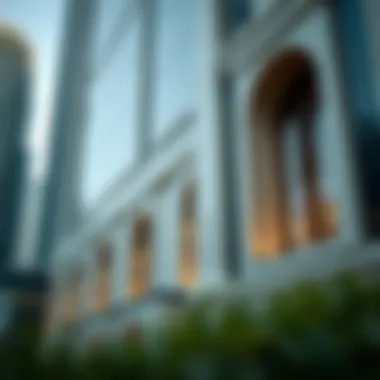

- Commercial Space: The tower offers significant commercial real estate, appealing to businesses looking for a prestigious address. The mix of office spaces and retail outlets can provide reliable income streams.
- High-Quality Amenities: With top-of-the-line facilities, the appeal of Latifa Tower stretches beyond mere aesthetics. Investors can benefit from the demand for premium office space, which typically commands higher rents.
- Future Developments: Ongoing infrastructural developments and urban enhancements in the neighborhood further boost the growth potential of Latifa Tower. As new projects emerge, they often enhance surrounding property values.
Investors willing to stake a claim in Latifa Tower will find themselves in a position ripe with possibilities, maximizing return potential in a quickly evolving landscape.
Real Estate Trends Surrounding World Trade Center
The World Trade Center represents a critical node in Dubai's real estate ecosystem, with trends indicating an unwavering demand for space within its walls. Understanding the real estate trends in this area can yield significant insights for prospective investors.
- Increased Demand for Office Space: Post-pandemic recovery has seen a surge in the demand for office environments that support flexible working practices. The World Trade Center, with its comprehensive facilities, meets this demand seamlessly.
- Residential Developments: The areas surrounding the World Trade Center are seeing burgeoning residential projects aimed at accommodation for expatriates and professionals. This increased housing availability correlates to a spike in the demand for office space, creating a symbiotic relationship.
- Mixed-Use Growth: The trend toward mixed-use developments continues to gain momentum. Investors can capitalize on spaces that blend living, working, and leisure components, which appeal to a broad demographic.
Those looking at the World Trade Center should remain vigilant about emerging trends and the economic indicators that come along with them. This awareness can position savvy investors for growth as the market evolves.
"Investing in prime locations like Latifa Tower and the World Trade Center can lead to both immediate and long-term gains, especially in a city known for its forward-thinking economic strategies."
In summary, the investment opportunities surrounding both Latifa Tower and the World Trade Center present a robust case for anyone looking to dive into the Dubai real estate market. Studying the potential of each tower offers a frame of reference for strategic investments, accommodating various investor profiles.
Sustainability Considerations
Sustainability considerations are at the forefront of contemporary architectural discourse, especially when examining mega-structures like Latifa Tower and the World Trade Center. Both buildings, standing proudly in the ever-evolving skyline of Dubai, represent more than just concrete and glass; they symbolize a commitment to environmentally conscious design and community welfare. As investors and stakeholders increasingly seek sustainable options, understanding the sustainable elements of these towers helps highlight their long-term economic and social viability.
*
Sustainability Features of Latifa Tower
Latifa Tower integrates various sustainable features aimed at minimizing environmental impact and promoting energy efficiency. One notable aspect is its smart building technology, which allows for real-time monitoring of energy consumption. This innovation isn't just a feather in its cap; it directly contributes to reducing electricity usage, saving costs in the long run.
- Rainwater Harvesting: One striking feature is the rainwater harvesting system that collects and recycles water used for irrigation and other non-potable purposes. This not only conserves water but also reduces the burden on local water supplies.
- Energy-efficient Materials: The choice of materials plays a crucial role in sustainability. Latifa Tower employs materials that have a lower carbon footprint during production and offer better insulation, cutting down the need for artificial cooling in the building.
- Green Roofs and Vertical Gardens: The vertical greenery wraps around the structure, enhancing insulation while promoting biodiversity in the urban landscape. These green installations also improve air quality, providing a healthier environment for its occupants.
These features collectively elevate Latifa Tower as an example of how modern architecture can harmonize with sustainability goals.
*
ECO-Friendly Innovations at World Trade Center
The World Trade Center also takes strides towards eco-friendliness, embodying innovations that significantly advance the goals of sustainable development. In an age where ecological concerns are paramount, the design and operational sustainability features of the World Trade Center are worth exploring.
- Solar Panels: One innovative feature includes the installation of solar panels that harness renewable energy. This not only reduces dependence on fossil fuels but significantly cuts electricity costs in the long term.
- Energy-efficient Systems: The building is equipped with advanced energy management systems that optimize heating, cooling, and lighting based on occupancy and environmental conditions. This is essential for minimizing waste and ensuring efficient use of resources.
- Sustainable Transportation Links: Aiming for a greener planet, the World Trade Center promotes the use of public transport and minimizes car dependency. This is achieved by offering extensive access to transit options, encouraging visitors and employees to opt for more sustainable modes of transportation, such as buses or subways.
Implementing these eco-friendly innovations positions the World Trade Center as not just an economic hub but also a model for sustainable urban living.
These efforts highlight the reality that economic prosperity and environmental sustainability can coexist, essential in today's architectural environments.
To sum up, both the Latifa Tower and the World Trade Center exemplify how contemporary architecture can leverage sustainable practices. Their respective features not only satisfy the aesthetic and functional needs of stakeholders but also pave the way for a greener future.
Community Impact
The community impact of notable structures like Latifa Tower and the World Trade Center is not just about the concrete and glass that form their shells. These buildings serve as pivotal components of their surroundings, shaping social dynamics, economic growth, and community identity. Their influence extends beyond mere physical presence; they symbolize aspirations, create jobs, and foster connectivity among residents.
This aspect is vital as it shows how major architectural works integrate into the fabric of urban society. It's about how they meet community needs, the enhancement of local amenities, and the encouragement of cultural activities. Understanding this impact helps stakeholders and potential investors better comprehend their roles in fostering harmonious communities.
Latifa Tower's Role in the Local Community
Latifa Tower stands as a beacon in its neighborhood, blending high-end living with an accessible approach to urban life. The tower is nestled within a vibrant community that thrives on multiculturalism. Here are a few points illustrating its significance:
- Community Hub: Latifa Tower is not just a residential space; it’s a meeting point for many who engage in various activities such as business networking, workshops, and social gatherings.
- Local Employment: The tower’s existence has spurred the creation of jobs. From construction to hospitality, many locals find employment in the services and facilities that support the tower.
- Cultural Exchange: The residents of Latifa Tower hail from diverse backgrounds, lending the community a rich blend of cultures and ideas. This environment fosters creativity and innovation, crucial for growth.
Latifa Tower contributes to community development by encouraging initiatives like local art exhibitions, health and wellness programs, and educational workshops. The building also collaborates with local organizations to enhance quality of life for its inhabitants.
Influence of World Trade Center on Community Development
The World Trade Center serves as more than just a commercial entity; its role in community development is profound. Here’s how it influences the local landscape:
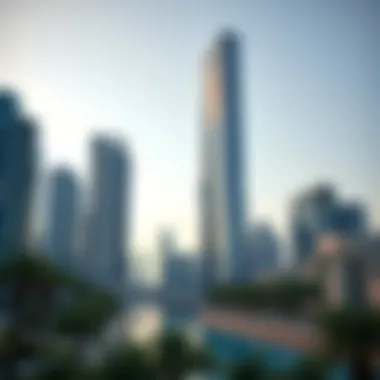

- Economic Stimulation: The World Trade Center attracts businesses from around the globe, which in turn creates a steady influx of visitors and investment into the area. The economic activity spurs the growth of local shops, restaurants, and services.
- Infrastructure Development: The presence of the World Trade Center has led to enhancements in local transportation and infrastructure. This includes improved roads and public transport options, making the area more accessible.
- Social Initiatives: The World Trade Center frequently engages in corporate social responsibility projects that benefit the local population. This includes educational programs, health screenings, and community clean-up events.
In summary, both Latifa Tower and the World Trade Center play crucial roles in their communities, fostering an environment that promotes growth, interaction, and connectivity. Educated investors and stakeholders should take note of these features, as they signify a commitment to long-term community welfare, which is increasingly a focal point for sustainable investment.
Connectivity and Accessibility
The significance of connectivity and accessibility cannot be overstated when discussing the impact of landmark structures like Latifa Tower and the World Trade Center. In the modern urban environment, seamless transportation links and easy access to buildings play a vital role in ensuring their success, both as commercial hubs and as residential landmarks. The design and planning of these towers cater to diverse populations, including investors, expatriates, and everyday commuters, thus enhancing their viability in a competitive real estate market.
Transportation Links for Latifa Tower
Latifa Tower stands as more than just a striking skyline feature; it is strategically situated at the heart of Dubai's intricate transport network. The effectiveness of its location is reflected in its proximity to key transport nodes, primarily the Sheikh Zayed Road, one of the busiest highways in the UAE. This connectivity allows both residents and visitors to travel seamlessly to various parts of the city.
- Metro Accessibility: The Dubai Metro serves as an essential mode of public transport. The nearest metro station is just a short walk away, making it convenient for commuters. This link is crucial as it reduces reliance on personal vehicles and promotes a shift toward public transport.
- Bus Networks: Furthermore, a robust bus network runs through the surrounding area. Regular services ensure that those using public transport can easily connect to nearby popular destinations, shopping malls, and commercial districts.
- Cycling and Walking Paths: In recent years, the drive towards sustainability has led to improved cycling and walking paths in the vicinity of Latifa Tower. These paths promote a healthier lifestyle and provide added convenience for those living nearby.
Overall, the transportation links for Latifa Tower contribute to its appeal as a prime location for both commercial endeavours and residential living, enhancing its status as a beacon of modern architecture.
Access Points for World Trade Center
The World Trade Center not only serves as an economic powerhouse but also prioritizes accessibility. The steps taken to ensure easy access are emblematic of Dubai's commitment to being a global hub for business and tourism.
- Proximity to Major Highways: Located near the main arterial roads, access to the World Trade Center is hassle-free, allowing for swift vehicle movement. This aspect is critical for businesses that rely on constant transportation of goods and services.
- Comprehensive Public Transport System: As with Latifa Tower, the World Trade Center is integrated into the extensive Dubai Metro system. The dedicated metro station nearby ensures that professionals and visitors can navigate the city efficiently, minimizing travel time.
- Multimodal Transport Options: The future of urban movement is multimodal. The World Trade Center encompasses options such as taxis, ride-sharing services, and even water taxis along Dubai Creek, enriching the transport landscape.
- Accessible Facilities: Lastly, the design of the World Trade Center includes considerations for those with mobility challenges. Ramps, elevators, and other facilities help ensure that everyone can access its offerings without barriers.
By prioritizing diverse transport options and accessibility for all, both Latifa Tower and the World Trade Center are set to remain central figures in Dubai's evolving urban narrative.
In summary, the careful planning regarding connectivity and accessibility for both structures significantly boosts their attractiveness. This focus not only enhances the experience for users but also solidifies their positions within Dubai's economic framework.
Future Prospects
Understanding the future prospects of both Latifa Tower and the World Trade Center is essential for stakeholders—be it investors, real estate agents, or community planners. These structures represent more than mere architectural achievements; they are beacons of potential growth, innovation, and sustainability in the heart of Dubai. As the skyline evolves, so do the opportunities for investment, development, and community integration.
Future Developments at Latifa Tower
Latifa Tower, being one of the more striking additions to Dubai's architectural landscape, is poised for numerous developments that enhance its appeal. Future expansions might include various multipurpose spaces—these could range from luxurious residential units to commercial establishments tailored for modern businesses. With urban living on the rise, it’s plausible to expect an advent of smart building technologies that could integrate seamlessly within the tower, ensuring energy efficiency and sustainability.
Moreover, collaborations with tech firms for virtual and augmented reality applications could redefine user experience within the tower itself. Information centers, offices, and public spaces might undergo a transformation to include interactive interfaces that offer residents and visitors insights into the building's rich offers and functional aspects. Investment in these enhancements would not only elevate property value but also broaden its market appeal.
"As Latifa Tower evolves, it is essential to keep the community perspective in mind, ensuring that advancements meet the needs of residents while attracting global visitors."
Anticipated Trends for World Trade Center
The World Trade Center has long been a linchpin for economic activity in Dubai. Looking ahead, several trends are likely to shape its future. A significant emphasis will be placed on sustainability practices, particularly as global standards elevate. This could manifest in the incorporation of green technologies, such as solar panels and energy-saving systems, which will significantly lower the center's carbon footprint.
Furthermore, as remote work continues to permeate the workforce, there’s an increasing necessity for flexible office spaces within the World Trade Center. To address this shift, versatile work environments that cater to both traditional and remote workers may emerge, providing shared facilities and collaborative spaces.
Lastly, as Dubai positions itself as a major player in international relations and commerce, recurring global events positioned at the World Trade Center will likely attract a multitude of international businesses and diplomats. This trend not only elevates the significance of the space but could drive enhancements in transport connectivity and accessibility, reinforcing its role as a vital hub in the region.
In summary, both Latifa Tower and the World Trade Center are set for evolutionary paths that foster sustainable growth, embrace technological advancements, and respond to changing market demands. Investors and stakeholders should keep a watchful eye on these developments, as they will undeniably shape Dubai's urban landscape and economic vitality for years to come.
End
The conclusion serves as a pivotal segment in any comprehensive analysis, especially when dissecting two striking monuments of modern architecture: Latifa Tower and the World Trade Center. This section ties together the diverse strands explored throughout the article, encapsulating the essence of both structures in the broader context of Dubai’s evolving urban landscape.
Summary of Findings
To summarize, Latifa Tower and the World Trade Center are not merely structures that scrape the sky; they are emblematic representations of Dubai's aspirations and innovations. Both towers stand tall as testament to the city's exceptional growth trajectory and economic ambitions.
In examining their architectural features, we found that Latifa Tower showcases a contemporary design that integrates functionality with aesthetic appeal, while the World Trade Center illustrates a blend of utility and grandeur. Economic functions within these edifices extend beyond mere office space; they reflect real-life implications for investors and tenants alike.
Moreover, sustainability remains at the forefront of modern developments in Dubai, as seen in the eco-friendly initiatives associated with both structures. The community impacts delve deeper than the surface-level engagements, highlighting how these towers foster local engagement, provide employment, and serve as avenues for cultural exchange.
Final Thoughts on Investment Potential
In light of the findings presented, the investment potential surrounding Latifa Tower and the World Trade Center cannot be overlooked. For investors, the economic vibrancy surrounding these landmarks presents numerous opportunities. Understanding the local market trends and anticipated developments can yield promising returns.
In addition, those aiming to navigate Dubai’s dynamic real estate market will find these properties particularly appealing. With a robust demand for commercial and residential spaces, these towers will likely maintain their value and prestige in the years ahead.
As such, they stand as both architectural marvels and wise investments, ready to welcome prospective investors committed to harnessing Dubai's growth.
"In the heart of Dubai, two towers tell a tale of ambition, resilience, and opportunity that resonates beyond the skyline."
Ultimately, for investors, agents, analysts, expatriates, and buyers, a thorough understanding of these critical structures reveals not only the architectural brilliance inherent in their making but also offers insights into a lucrative future in Dubai's ever-evolving urban tapestry.

